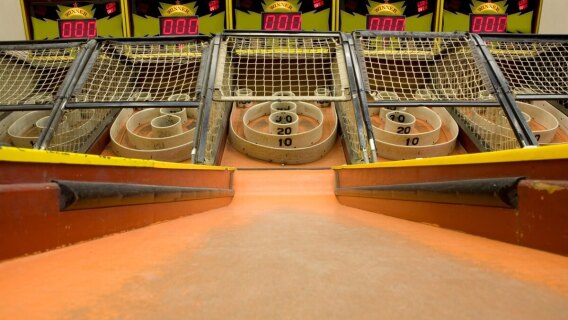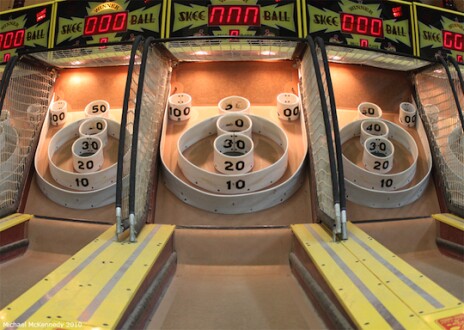Deciding What to Shoot For
Market Timing Trumps Everything
A Bank Stock for the Current Market
---
In February 2011, Chloe Lutts, who edits Dick Davis Investment Digest and Dick Davis Dividend Digest, wrote in a Cabot Wealth Advisory about her love of Skee-Ball, an old arcade game that has attracted competitive leagues in several cities.
I never played Skee-Ball until I came to the East Coast—either it’s more popular in the East or I just didn’t hang out at the right arcades and amusement parks when I was living out West. But either way, I’ve become a devoted player, always happy to hear the 10 composition balls rolling down the chute when I drop in the quarter. I have hundreds of the perforated reward tickets in a drawer at home. I’m waiting to turn them in until I accumulate enough to get something really valuable, like an eight-track cassette of Foghat’s Greatest Hits.
Skee-Ball was invented in Philadelphia in 1909, and the alley was originally 36 feet long. Needless to say, this made it a little strenuous for the junior set. In 1928, the current 14-foot alley was made the standard and the game took off, with the first national tournament being held in Atlantic City in 1932.
In her Cabot Wealth Advisory, Chloe made an interesting parallel between certain aspects of Skee-Ball and stock investing. I’m running her entire column here, and then I’ll have a few observations to make at the end.
How Is Skee-Ball Like Investing?
By Chloe Lutts, Originally published February 15, 2011
Aside from investing, I have a few hobbies and interests.
I like to cook. I enjoy yoga and snowboarding. I read, a lot.
And I play competitive Skee-Ball every Sunday night.
Competitive Skee-Ball hasn’t quite attained the popularity of league bowling, or chess … or even Scrabble. But it has a growing following in New York and a few other cities. There are over 50 teams in my Brooklyn league, which is in its 15th season. The first National Championship was held last year.
Skee-Ball doesn’t take much athletic ability, but it does involve some strategy, and lots of practice.
And, I realized the other day, it’s also a very good metaphor for some aspects of investing.
As you can tell from the picture above, the point values on each target cup reflect the difficulty of getting the ball into that hole. What fewer people realize is that the point values also reflect the risk associated with making each shot. And that’s where Skee-Ball is like investing.
Take the 100 cup, for instance. It’s worth twice as many points as the second-highest cup (worth 50 points) because it’s smaller and way up there in the corner—but also because if you shoot for it and miss, your ball will most likely fall into the 10.
In that way, the “hundo” cup, as it’s called, is a lot like small-cap stocks. If you roll for a hundo and make it, it gives your score a very significant boost. Pick a little-known small-cap stock that turns out to be a big winner, and you’ll see the same effect on your portfolio. However, if you miss your shot, you only get a 10. In much the same way, if your small-cap stock doesn’t turn out to be a big winner, it may waffle around the same level forever—and could even go bankrupt. And the hundo is a hard shot to make—most people miss most of the time.
The 40 and 50 are a little easier. I think of them as the growth stocks. They’re also less risky than the 100 cups. Miss a 40, and you’ll probably at least get a 20—you may even get a 30. And if you overshoot, you could get a 50! The 40’s sweet spot right in the middle is why it’s the hole most players—including me—aim for.
Slightly better players will aim for the 50—however, the 50 isn’t within the 20 ring, so there’s a good chance of getting a 10 if you miss. I think of the 50 as representing more speculative growth stocks—companies that at least have positive earnings, but not much institutional support or history.
How you decide to play is a lot like building a portfolio. My 40-focused strategy is analogous to buying a portfolio full of stocks with good support and medium risk—I think of them as not-quite-blue-chips like Ameriprise Financial (AMP), Baidu (BIDU), Corning (GLW), Great Lakes Dredge and Dock (GLDD), Netflix (NFLX), NVIDIA (NVDA), Symantec (SYMC), The Mosaic Company (MOS) and Union Pacific (UNP). They have strong charts, growing earnings, and increasing support. They may not be household names, but investors are aware of them and they have strong institutional support. They probably aren’t 10-baggers at this point, but it’s unlikely you’ll lose all your money in them either.
50-style stocks are a little more speculative—they’re not as tested as the almost-blue-chips, but they have a little more potential: stocks like LDK Solar (LDK), TriQuint Semiconductor (TQNT), MercadoLibre (MELI) and Allot Communications (ALLT). These ones are a little more likely to surprise you—possibly to the downside. But they also have more room to grow.
Then there’s hundo stocks: There are obviously hundreds of unknown little small-cap companies out there, but a few that have been recommended in the Dick Davis Digests recently are Elephant Talk Communications (ETAK), Verenium (VRNM), SunOpta (STKL) and Beacon Enterprise Solutions Group (BEAC). These stocks have little-to-no institutional support, and may go nowhere. Some of them don’t even have positive earnings. But if you pick well, they can repay you well.
Putting together a balanced portfolio is a lot like rolling a game of —you have to assess your skill level, risk tolerance and goals, and allocate your funds, or balls, accordingly.
In a Skee-Ball game you only get nine balls—obviously, a well-balanced portfolio can have more stocks than that. But it’s still wise for most growth investors to limit their portfolios to a reasonable number of stocks, to allow the winners to really shine (setting aside for now investing systems that rely on holding dozens of stocks).
For investors who want peace of mind and medium risk, filling your portfolio with 40-stocks is a fine strategy. Some will underperform, but like an underthrown 40 shot, they’ll probably at least turn out to be 20s. Overall, a 40-focused strategy is a good choice for investors who want to grow the value of their portfolio without it keeping them awake at night.
Investors with a little more risk tolerance might want to add some 50-stocks in an attempt to juice their returns. Aggressive investors who are confident in their abilities may even rely solely on 50-style stocks.
Then there’s the hundo stocks. Like most investors, most Skee-Ball rollers don’t even try for the hundo. Like picking a winning small cap, rolling a hundo takes lots of practice, and specialized skill. And even the best hundo rollers miss regularly.
However, one of the rollers I play with has figured out a good way to add some hundo potential to his game, without risking a complete wash. Rather than going for the hundo on all nine balls (which all too often results in a score of 90, derisively called a “right angle”), he goes for the hundo on only the first three of his nine balls. If he sinks one or two, he has a nice head start, and if he misses all three, he can still get a decent score by rolling 40s and 50s.
In the investing world, that’s roughly equivalent to adding a few high-risk small-caps to an otherwise growth-oriented portfolio. If even one of them turns out to be a big winner, your portfolio will reap the benefit. And if none of them go anywhere, you haven’t lost your shirt. For investors with a decent tolerance for risk, and the time and inclination to do the research involved in buying small caps, it can be a rewarding strategy.
What kind of investor are you? Do you roll all 40s, or do you throw some 50s and 100s into the mix? Or are you a straight hundo roller, risking a right angle once in a while but also hoping for that big 900 (the highest possible score in Skee-Ball; not yet accomplished in league play)?
---
As someone who writes about growth investing all the time (and edits Cabot China & Emerging Markets Report), I think Chloe is spot on with her analogy. There are no high returns without accepting proportionally high risk.
I was curious to know how Chloe’s examples of each risk level had performed since this CWA was originally published. The price performance of her 17 picks was all over the place, mostly because the markets have been all over the place in the 20 months since she did her writing.
One of her 40s (Union Pacific UNP) has made a nice gain of 21%. And one of her 50s (Allot Communications ALLT) popped a gain of 41%, while another, MercadoLibre (MELI), edged up a couple of percent. I won’t even mention LDK Solar (LDK), which has scrubbed off 93% of its price.
But growth investing isn’t a buy-and-hold strategy, and a nimble investor would have had good chances to pocket money from many of these stocks if good sell disciplines had been in place.
But the real lesson of the results is one that I keep emphasizing over and over, and will probably continue to stress until I can’t type any more. And that is that, while good stock selection is important, market timing is immensely more important in determining your ultimate results.
Chloe’s examples were picked in February 2011, when the S&P 500 Index was near a multi-year high as it recovered from its trough in March 2009. The S&P started trading sideways soon afterward, and volatility was all over the place.
Cabot’s growth advisories all went heavily into cash as the markets hacked around, and virtually all of Chloe’s picks would have been sold when market timing indicators turned negative.
So the moral of the story, at least as far as I’m concerned, is that when the markets turn sour, Skee-Ball is by far a better thing to be doing than trying to ferret out winning growth stocks.
---
My stock pick for today—Deutsche Bank (DB)—is specially tailored for the kind of trying times we’re having in the market. It’s a big company (market cap over $38 billion and $2.8 trillion in assets), the largest financial institution in Germany. It pays an annual dividend yield of 2.2% and a P/E ratio of about 11.
Obviously there’s no mistaking Deutsche Bank for a growth stock. On the other hand, DB has been in a long downtrend since it topped out at 146 back in April 2007. That’s not exactly unexpected for a company that was up to its armpits in heavily leveraged mortgages during the Housing Bubble. And it doesn’t help that the bank, although not heavily exposed to Greece, has lots of exposure to Italy and Spain, and is a major player in the eurozone and dependent on what happens there.
The investment thesis on Deutsche Bank is that it’s a relatively cheap play on a successful resolution to the eurozone/Greek debt crisis. The stock has bounced from a low of 27 in July to 43 in recent trading. DB is riding its 50-day moving average higher, defying the downward pull of the market in the last few weeks. This kind of relative strength is an important sign that investors see DB as a valid counterplay.
I think a small bet on DB, with a tight stop at 39 and a resolve to wait out the European debt crisis, could pay off well. I have the stock in the portfolio of the Cabot China & Emerging Markets Report as a defensive pick as we wait patiently for markets to chew their way through this period of dodgy global growth and European weakness.
Sincerely,
Paul Goodwin
Editor of Cabot China & Emerging Markets Report
---


